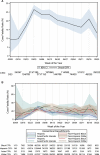Racial and Ethnic Differences in Presentation and Outcomes for Patients Hospitalized With COVID-19: Findings From the American Heart Association's COVID-19 Cardiovascular Disease Registry
- PMID: 33200953
- PMCID: PMC8126640
- DOI: 10.1161/CIRCULATIONAHA.120.052278
Racial and Ethnic Differences in Presentation and Outcomes for Patients Hospitalized With COVID-19: Findings From the American Heart Association's COVID-19 Cardiovascular Disease Registry
Abstract
Background: The coronavirus disease 2019 (COVID-19) pandemic has exposed longstanding racial and ethnic inequities in health risks and outcomes in the United States. We aimed to identify racial and ethnic differences in presentation and outcomes for patients hospitalized with COVID-19.
Methods: The American Heart Association COVID-19 Cardiovascular Disease Registry is a retrospective observational registry capturing consecutive patients hospitalized with COVID-19. We present data on the first 7868 patients by race/ethnicity treated at 88 hospitals across the United States between January 17, 2020, and July 22, 2020. The primary outcome was in-hospital mortality. Secondary outcomes included major adverse cardiovascular events (death, myocardial infarction, stroke, heart failure) and COVID-19 cardiorespiratory ordinal severity score (worst to best: death, cardiac arrest, mechanical ventilation with mechanical circulatory support, mechanical ventilation with vasopressors/inotrope support, mechanical ventilation without hemodynamic support, and hospitalization alone. Multivariable logistic regression analyses were performed to assess the relationship between race/ethnicity and each outcome adjusting for differences in sociodemographic, clinical, and presentation features, and accounting for clustering by hospital.
Results: Among 7868 patients hospitalized with COVID-19, 33.0% were Hispanic, 25.5% were non-Hispanic Black, 6.3% were Asian, and 35.2% were non-Hispanic White. Hispanic and Black patients were younger than non-Hispanic White and Asian patients and were more likely to be uninsured. Black patients had the highest prevalence of obesity, hypertension, and diabetes. Black patients also had the highest rates of mechanical ventilation (23.2%) and renal replacement therapy (6.6%) but the lowest rates of remdesivir use (6.1%). Overall mortality was 18.4% with 53% of all deaths occurring in Black and Hispanic patients. The adjusted odds ratios for mortality were 0.93 (95% CI, 0.76-1.14) for Black patients, 0.90 (95% CI, 0.73-1.11) for Hispanic patients, and 1.31 (95% CI, 0.96-1.80) for Asian patients compared with non-Hispanic White patients. The median odds ratio across hospitals was 1.99 (95% CI, 1.74-2.48). Results were similar for major adverse cardiovascular events. Asian patients had the highest COVID-19 cardiorespiratory severity at presentation (adjusted odds ratio, 1.48 [95% CI, 1.16-1.90]).
Conclusions: Although in-hospital mortality and major adverse cardiovascular events did not differ by race/ethnicity after adjustment, Black and Hispanic patients bore a greater burden of mortality and morbidity because of their disproportionate representation among COVID-19 hospitalizations.
Keywords: COVID-19; cardiovascular diseases; health status disparities; race factors.
Figures

Comment in
-
To Solve Racial and Ethnic Disparities in COVID-19 Outcomes, Look Upstream for Solutions.Circulation. 2021 Jun 15;143(24):2343-2345. doi: 10.1161/CIRCULATIONAHA.120.052713. Epub 2021 Jun 14. Circulation. 2021. PMID: 34125561 Free PMC article. No abstract available.
References
-
- Yancy CW. COVID-19 and African Americans. JAMA. 2020;323:1891–1892. doi: 10.1001/jama.2020.6548 - PubMed
-
- Mukherjee V, Toth AT, Fenianos M, Martell S, Karpel HC, Postelnicu R, Bhatt A, Deshwal H, Kreiger-Benson E, Brill K, et al. Clinical outcomes in critically ill coronavirus disease 2019 patients: a unique New York City public hospital experience. Crit Care Explor. 2020;2:e0188. doi: 10.1097/CCE.0000000000000188 - PMC - PubMed
Publication types
MeSH terms
Grants and funding
LinkOut - more resources
Full Text Sources
Medical

